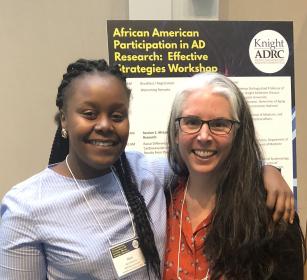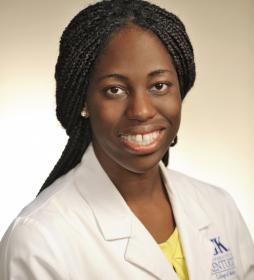
Image: NIA 2018 National Strategy for Recruitment and Participation in AD and Related Dementias Clinical Research
Inspired by lessons from last fall's WU Knight ADRC and National Institute on Aging workshop on research participation strategies, our team looked at the challenges that hinder African American participation in brain health research and the work being done to affect the health outcomes of underserved populations.
By Alice Mukora
As published in Dimensions Magazine - Spring 2019
Alice Mukora is a Research Associate who studies the progression of neurodegenerative disease at the Allen Institute for Brain Science in Seattle. She recently volunteered at the UW Memory and Brain Wellness Center.
This fall, I traveled to the Knight ADRC of Washington University in St. Louis to attend a conference on African American participation in Alzheimer’s disease research. Leaders in the field convened to discuss problems around effective ways to engage with and attend to the needs of the African American community and suggest effective solutions to the challenges of recruiting diverse participants in Alzheimer’s research. I came away from the experience feeling empowered to take a deeper look at the challenges that dampen African American participation in health research and the impressive work that is being done to affect the health outcomes of underserved populations and increase health equity.
Alzheimer’s disease, the leading cause of dementia, is a public health issue, with projections that over 13 million Americans will be affected by the disease by the year 2050. Of that population, over 40 percent of those affected will be minorities. However, these estimates are limited because of the low enrollment of minorities in dementia research. Considering the scale of the disease’s impacts, the NIH has heightened the call for the research community to address the diversity of the public while developing strategies to impact Alzheimer’s disease.
Much of ongoing Alzheimer’s disease research does not successfully reach groups outside of the non-Latino white population. As a result, much of what we know about the disease does not necessarily reflect the diversity of those who are affected. In fact, groups which are most vulnerable to dementia have not been well represented in research, such as the African American community. The Alzheimer’s Association estimates that African Americans are twice as likely to have Alzheimer’s disease as their non-Latino white counterparts, but they are less likely to have received a diagnosis or treatment. They are also substantially underrepresented in research, which dims the hope of translating research findings into actionable information that benefits the health of all people. The lack of minority participation in research negatively impacts how we understand the disease and our ability to develop effective treatments or intervention.
In discussions about increasing diversity in research, a key question often arises: What are the barriers that hinder African American participation in research? “Actually, I think the better question is what barriers are being put up by the scientific and medical community that hinder African Americans from wanting to participate,” says Dr. Eseosa Ighodaro, PhD, a neuroscientist and a medical student at the University of Kentucky who published a paper in the Journal of Alzheimer’s Disease to address the challenges and provide considerations associated with studying dementia in African-Americans. “I think if you turn the question around and ask it that way, that puts the onus on us as a coalition of scientists and researchers to do a better job of reaching out to the African American community.”
One focus of the Knight ADRC Center workshop was examining these barriers that are in place that discourage or exclude African Americans from participating in research. Mistrust arose as key factor - a disconnect between the wants of the researchers and the African American community deter people from wanting to participate. “As you are thinking about biomedical research and healthcare research, I want you to keep some things in mind. There are historical underpinnings of unethical research,” said Dr. Joyce E. Balls-Berry of the Mayo Clinic, speaking at the Norman R. Seay Lecture which preceded the Knight ADRC workshop.
As recently as the 1990s, physicians and scientists conducted unethical biomedical experiments on African Americans. The legacy of studies like the Tuskegee Syphilis Trials lingers in the form of distrust of the biomedical research community and the healthcare system as a whole. People are wary of the intentions of research and unwilling to merely be subjects in a study.
“1990 is not far from today,” says Dr. Ighodaro. “Some of our mothers and grandmothers, grandfathers, brothers, sisters and uncles were there when these things happened, so I think Number One in addressing the mistrust is being brutally honest in acknowledging the medical community’s horrible track record of research on African Americans.”
Even with the ability to overcome a collective memory of mistreatment, an ineffective flow of information between researchers and study participants rekindles these feelings of distrust. This can be attributed to outreach and research methods that are not culturally competent, failing to collaborate with the local African-American community and honor its values and norms. Examples include research staff that do not reflect the diversity of the population being targeted, research requirements that are inaccessible or inconvenient, and inadequate community- and patient-based engagement. “What is ultimately missing is the perceptions and lived experiences of African-Americans.” said Dr. Crystal Glover of Rush University Medical Center, also speaking at the Knight ADRC workshop, who emphasized transparency before, during, and after clinical research is being conducted in order to optimize benefits for everyone involved.
A main takeaway from the workshop was that in order to overcome these barriers, it is of the utmost importance that researchers prioritize building a mutually beneficial and sustainable relationship with a community to ensure that people are active and immersed participants in research.
The workshop offered great examples at institutions across the country where innovative methods have been put in place to rebuild trust with the local African American community. Many of these methods exude the importance of the reciprocity and meaningful presence that researchers need to establish before recruiting for clinical research. Before developing a highly successful center created to empower the local community, Dr. Goldie S. Byrd of Wake Forest Baptist asked, “What [do the people] need for us to do and to sustain their interest, not only in research?” Out of Dr. Byrd’s efforts, the Center for Outreach in Alzheimer’s, Aging, and Community Health (COAACH) in Greensboro was created to help families, and help communities empower themselves around Alzheimer’s disease, Alzheimer’s management, and Alzheimer’s care. It had the effect of increasing research study participation in the area as more families became informed and educated on the disease and more organically were drawn to participate in research. This community investment methodology, which is integral to the success of COAACH, prioritizes finding dignified ways to support the community beyond the pretense of research recruitment.
Alongside creating new spaces to empower the community, other institutions have made efforts to facilitate more cohesive interaction between those conducting research and the African-American community. One such method is mobilizing spaces that are embedded into the African American community, such as churches, to do outreach that is purposeful and already tied to the community. Dr. Stephen B. Thomas, Director of the Maryland Center for Health Equity, championed “implementing effective prevention programs that are actually tailored to the community” at the workshop. In his own work with developing the Health Advocates In-Reach and Research Campaign (HAIR), he has been able to leverage the culturally-important setting of African-American barbershops and beauty salons to deliver health education and health services.
Dr. Thomas and his team have able to utilize this existing infrastructure, both as a place of community-building and strong relationships between barbers and stylists and their customers. The campaign brought health professionals and health education to underserved communities and trained barbers as health advocates. This philosophy of promoting self-advocacy within the community is echoed in other methods, such as the ADRC’s commitment to recruit more diverse research and outreach staff that have connections with the community. Sometimes the lack of diversity in research participation is not helped by the lack of diversity among those doing the research; Alzheimer’s disease researchers and medical providers. Substantial relationships are built when those who are a part of the community are involved in contributing to finding a solution to the health problems that affects them and their neighbors.
When dealing with a disease that touches every community, we need comprehensive research to understand its impacts on the health and well being of all. The dearth of African-American representation in Alzheimer’s disease research is a problem with many complexities, and innovation will be the impetus to address and rectify this imbalance. This innovation should be well thought out and purposeful, but it also must be dynamic and change as needed.
“Not only must participation reflect the current diversity and demographics of our region, but we also must anticipate future demographics and consider future community needs,” said Jessica McDougall, ADRC research coordinator, who also attended the Knight workshop.
On this journey, I have been humbled and inspired by the work being done by the many Alzheimer’s Disease Centers represented at the workshop to adapt and accommodate changing needs, and I am excited to see how these philosophies can be expanded to other underrepresented and underserved groups in research. •






